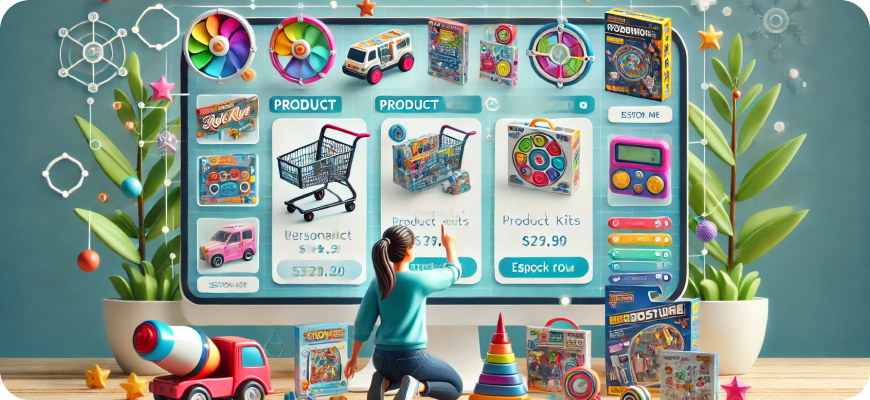Do I Need a Brand for My E-commerce? All You Should Know About E-commerce Branding
In today’s fast-paced e-commerce landscape, where thousands of online stores are vying for customer attention, building a strong brand can make or break your success. Branding is more than just having a logo, a name, or a visually appealing website. It is about creating an emotional connection with your customers, differentiating yourself from the competition, and cultivating loyalty and trust.
But do you really need a brand for your e-commerce business? The short answer is yes. Here’s everything you need to know about e-commerce branding and why it’s crucial to your success.

What is E-commerce Branding?
E-commerce branding refers to the process of creating a unique identity and image for your online store that resonates with customers and reflects your values, mission, and products. It encompasses your store’s visual elements (logo, colors, fonts), messaging (tone of voice, values, storytelling), customer experience, and more.
Branding is what makes customers remember your store, connect with it on a deeper level, and prefer you over competitors. It goes beyond mere transactions; it builds relationships that lead to repeat purchases, word-of-mouth marketing, and increased customer loyalty.
Why is Branding Important for E-commerce?
1. Differentiates You From Competitors
In a crowded marketplace, having a distinct brand identity sets you apart from competitors who may be selling similar or identical products. Your brand communicates why your e-commerce store is unique and gives potential customers a reason to choose you.
For example, Apple isn’t just a technology company; it’s a lifestyle brand known for innovation, minimalism, and high-quality design. Customers choose Apple because they resonate with the brand’s values and vision.
2. Builds Trust and Credibility
A strong brand establishes trust and credibility with your audience. Customers are more likely to buy from a store that looks professional, has a consistent brand message, and demonstrates authority in its niche. Trust is especially critical for online shopping, where customers are cautious about sharing their payment information.
For instance, a well-designed website with cohesive branding elements signals professionalism and reliability. In contrast, a poorly designed store with inconsistent messaging may drive customers away.
3. Encourages Customer Loyalty
Branding goes beyond acquiring new customers; it focuses on creating loyal customers who repeatedly buy from you. Strong brands create emotional connections and experiences that keep customers coming back for more. Loyal customers are also more likely to refer your store to friends and family, generating organic growth.
A great example of brand loyalty is Nike. Customers buy Nike products not just for their functionality but because they identify with the brand’s “Just Do It” philosophy and aspirational lifestyle.
4. Increases Customer Perceived Value
Effective branding increases the perceived value of your products. When customers associate your brand with quality, luxury, or a specific lifestyle, they are often willing to pay a premium. Branding allows you to position your e-commerce store as more than just a seller of products but as a purveyor of experiences.
Consider luxury brands like Gucci or Chanel. Their branding elevates their products beyond functionality, allowing them to charge premium prices while maintaining a loyal customer base.
5. Supports Marketing Efforts
A well-defined brand simplifies your marketing efforts by providing a clear direction and consistent messaging. Whether you’re creating social media posts, email campaigns, or advertisements, your brand’s tone of voice, values, and visuals ensure that customers instantly recognize and connect with your store.
6. Improves Brand Recall and Recognition
Branding makes your e-commerce store memorable. Customers are more likely to remember and return to a store with a distinct identity and message. When customers recognize and recall your brand easily, they are more likely to think of you when they need products in your niche.
Essential Elements of E-commerce Branding
To build a strong brand for your e-commerce store, you need to focus on several key elements:
1. Brand Identity
Your brand identity consists of the visual elements that represent your brand, such as your logo, color scheme, typography, and imagery. It’s what customers see when they visit your website, social media pages, or physical products.
Tips for creating a strong brand identity:
- Logo Design: Your logo should reflect your brand’s personality and values. Keep it simple, memorable, and versatile for use across different mediums.
- Color Scheme: Colors evoke emotions and influence perceptions. Choose a color palette that aligns with your brand’s personality and resonates with your target audience.
- Typography: Use fonts that complement your brand’s style and tone of voice. Consistent typography enhances your brand’s professionalism and cohesion.
- Imagery and Graphics: Use high-quality images, icons, and graphics that convey your brand’s values and appeal to your target market.
2. Brand Messaging
Your brand messaging is the voice and tone you use to communicate with customers. It includes your tagline, mission statement, product descriptions, and the overall language you use.
Key aspects of brand messaging:
- Value Proposition: Clearly articulate what makes your brand unique and why customers should choose you.
- Tone of Voice: Are you formal, playful, authoritative, or conversational? Your tone should align with your brand’s personality and resonate with your audience.
- Storytelling: Share your brand’s story, values, and mission. Customers love connecting with brands that have an authentic narrative.
3. Customer Experience
Your brand is more than what you say—it’s what you do. The customer experience you deliver plays a significant role in shaping perceptions of your brand.
Improving customer experience:
- Seamless Website Navigation: Make it easy for customers to find what they’re looking for.
- Responsive Customer Support: Offer prompt and helpful support through email, chat, or phone.
- Fast Shipping and Easy Returns: Create a hassle-free purchasing and return experience.
- Personalization: Tailor product recommendations, email campaigns, and promotions to individual customer preferences.
4. Consistency Across Channels
Brand consistency is crucial for building trust and recognition. Whether customers interact with your brand on social media, your website, or through email marketing, they should experience the same look, tone, and values.
Building Your E-commerce Brand: Steps to Follow
1. Define Your Target Audience
Understanding your target audience is the first step in creating a brand that resonates. Identify their demographics, preferences, pain points, and buying behaviors. This information will shape your brand’s messaging, design, and marketing strategies.
Questions to ask:
- Who is my ideal customer?
- What problems does my product solve for them?
- What are their values, interests, and lifestyle?
2. Research Competitors
Analyze your competitors’ branding strategies to identify gaps and opportunities in the market. Look at their messaging, visual identity, customer experience, and unique selling points (USPs). Your goal is not to copy but to find ways to differentiate your brand.
3. Create a Unique Value Proposition (UVP)
Your UVP is the reason customers should buy from you rather than your competitors. It should be concise, compelling, and clearly communicate the benefits of your products.
Example UVPs:
- “Handcrafted leather bags that last a lifetime.”
- “Eco-friendly skincare for sensitive skin.”
4. Develop Your Brand Identity
Create a cohesive brand identity that reflects your UVP and resonates with your target audience. Design a logo, choose colors, select fonts, and create visual elements that align with your brand’s personality.
5. Craft a Brand Story
Every successful brand has a compelling story that connects with its audience. Your story should highlight your brand’s mission, values, and journey. Share why you started your business, the challenges you’ve overcome, and the values that drive your decisions.
6. Build a Professional Website
Your website is the online face of your brand. It should be visually appealing, user-friendly, and optimized for conversions. Use your brand colors, fonts, and messaging consistently across your website.
Key pages to include:
- Homepage: Clearly communicate your UVP and guide visitors to products.
- About Us: Share your brand story and values.
- Product Pages: Use high-quality images, detailed descriptions, and customer reviews.
- Contact Page: Make it easy for customers to get in touch.
7. Leverage Social Media
Social media is a powerful tool for building brand awareness and connecting with your audience. Share engaging content that reflects your brand’s personality, such as product updates, behind-the-scenes content, user-generated content, and more.
Tips for social media branding:
- Use consistent visuals and tone of voice across all platforms.
- Engage with followers by responding to comments and messages.
- Collaborate with influencers to reach new audiences.
8. Provide Exceptional Customer Service
Great customer service strengthens your brand’s reputation and fosters loyalty. Be responsive, proactive, and empathetic to customer needs.
Ideas for improving customer service:
- Offer 24/7 live chat support.
- Send follow-up emails after purchases to check on customer satisfaction.
- Resolve complaints quickly and fairly.
9. Collect and Showcase Customer Reviews
Customer reviews and testimonials provide social proof and build trust. Encourage customers to leave reviews and showcase positive feedback on your website, social media, and marketing materials.
10. Measure and Refine Your Branding Efforts
Monitor the performance of your branding efforts using metrics such as customer retention rate, repeat purchases, social media engagement, and website traffic. Use data to refine your strategies and continuously improve your brand’s impact.
Common Mistakes to Avoid in E-commerce Branding
- Inconsistent Branding: Inconsistency in visuals, messaging, or tone can confuse customers and erode trust.
- Neglecting Your Audience: Your brand should reflect the needs and values of your target audience, not just your personal preferences.
- Overlooking the Importance of Quality: Your brand reputation is tied to the quality of your products and services. Ensure every aspect of your business reflects your brand’s values.
- Ignoring Feedback: Listen to customer feedback and use it to improve your brand experience.

Conclusion
In the competitive world of e-commerce, branding is not an optional extra—it’s a necessity. A strong brand differentiates you from competitors, builds trust, fosters customer loyalty, and elevates your business beyond a transactional relationship with customers. By focusing on your brand identity, messaging, customer experience, and consistency, you can create a memorable brand that resonates with your audience and drives long-term growth.
Invest time and resources into building your brand, and you’ll reap the rewards of loyal customers, increased sales, and lasting market presence. Branding is a journey, not a destination—continuously refine your efforts to stay relevant and connected with your audience.






